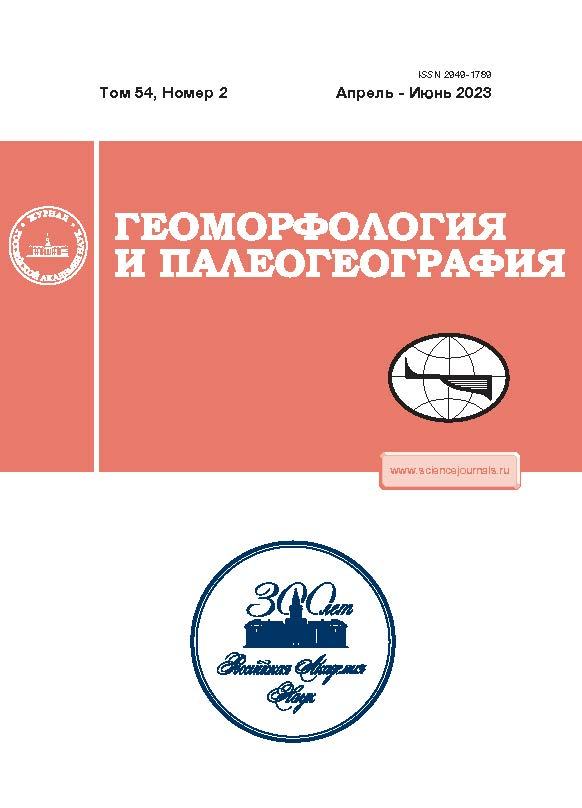FLUCTUATIONS OF LAKE NERO DURING THE HOLOCENE1
- Authors: Konstantinov E.A.1, Karpukhina N.V.1, Zakharov A.L.1, Bricheva S.S.1,2, Ukraintsev V.Y.1, Lazukova L.I.1, Rudinskaya A.I.1
-
Affiliations:
- Institute of Geography, Russian Academy of Sciences
- Lomonosov Moscow State University, Faculty of Geology
- Issue: Vol 54, No 2 (2023)
- Pages: 51-60
- Section: History of landform development, palaeogeography
- URL: https://journals.rcsi.science/2949-1789/article/view/139459
- DOI: https://doi.org/10.31857/S2949178923020044
- EDN: https://elibrary.ru/ECGAPL
- ID: 139459
Cite item
Abstract
The paleohydrological condition in the Rostov depression (Yaroslavl region) has been the subject of many years of discussions. The ideas about the Holocene fluctuations of the Lake Nero level differ among researchers. We have studied the structure of bottom sediments and bottom topography in the deepest northeastern part of the lake. A bathymetric survey was carried out. Drilling with the selection of undisturbed columns, GPR profiling, radiocarbon dating and a set of lithological analyzes were performed. Stratigraphic unconformities in the structure of bottom sediments indicate a drop in the lake level during the Lateglacial and the early Holocene. The level dropped to 87 m asl, which is 7 m lower than the current water level in the lake. The size of the lake at this stage was reduced several times. From 9 to 6.5 ka BP a transgressive stage was established: the average level of the lake could have risen to 91–94 m asl, which is close to its modern level. From 6.5 to 2.4 ka BP a decrease in the level by 1–3 m below the current one is revealed, followed by a gradual increase in the level. The current level was reached 300–500 years ago. The main factor in the fluctuations in the level of Lake Nero in the Holocene is the change in the height of the runoff threshold, caused by the transformation of the Ustye, Veksa, and Kotorosl river sistems. This transformation was associated both with regional changes in fluvial activity and with the processes of self-development of river channels.
About the authors
E. A. Konstantinov
Institute of Geography, Russian Academy of Sciences
Author for correspondence.
Email: eakonst@igras.ru
Russia, Moscow
N. V. Karpukhina
Institute of Geography, Russian Academy of Sciences
Email: eakonst@igras.ru
Russia, Moscow
A. L. Zakharov
Institute of Geography, Russian Academy of Sciences
Email: eakonst@igras.ru
Russia, Moscow
S. S. Bricheva
Institute of Geography, Russian Academy of Sciences; Lomonosov Moscow State University, Faculty of Geology
Email: eakonst@igras.ru
Russia, Moscow; Russia, Moscow
V. Yu. Ukraintsev
Institute of Geography, Russian Academy of Sciences
Email: eakonst@igras.ru
Russia, Moscow
L. I. Lazukova
Institute of Geography, Russian Academy of Sciences
Email: eakonst@igras.ru
Russia, Moscow
A. I. Rudinskaya
Institute of Geography, Russian Academy of Sciences
Email: eakonst@igras.ru
Russia, Moscow
References
- Aleksandrovskii A.L. (2011). Soil evolution on the low terraces of Lake Nero. Eurasian Soil Science. Т. 44. No. 10. С. 1055–1067. https://doi.org/10.1134/s1064229311100024
- Barysheva A.A. (1953). Bassein ozera Nero: fiziko-geograficheskaya kharakteristika (Basin of Lake Nero: geographical characteristics). PhD thesis. Moscow: MOPI (Publ.), 16 p. (in Russ.)
- Bikbulatov E.S., Bikbulatova E.M., Litvinov A.S., Poddubnyj S.A. (2003). Gidrologiya i gidrokhimiya ozera Nero (Hydrology and geochemistry of the Lake Nero). Rybinsk: Rybinskii dom pechati (Publ.), 192 p. (in Russ.)
- Blaauw M., Christen J.A. (2011). Flexible paleoclimate age-depth models using an autoregressive gamma process. Bayesian analysis. Vol. 6. No. 3. P. 457–474. https://doi.org/10.1214/11-BA618
- Chizhikov N.V. (1956). Geomorphology and soils of the basin of Lake Nero and the river Ustye-Kotorosl. Tr. lab. sapropelevykh otlozhenii. No. 6. P. 130–144. (in Russ.)
- Dean W.E. (1974). Determination of carbonate and organic matter in calcareous sediments and sedimentary rocks by loss on ignition; comparison with other methods. Journal of Sedimentary Research. Vol. 44. No. 1. P. 242–248. https://doi.org/10.1306/74D729D2-2B21-11D7-8648000102C1865D
- Gunova V.S. (1975). Istoriya ozera Nero po paleobotanicheskim dannym (History of the Lake Nero according to paleobotanical data). PhD thesis. Moscow: MSU (Publ.), 21 p. (in Russ.)
- Gunova V.S., Leflat O.N. (1997). Holocene and current state of the ecosystem of Lake Nero. Vestnik Mosk. un-ta. Ser. 5. Geografiya. No. 4. P. 42–45. (in Russ.)
- Kvasov D.D. (1975). Pozdnechetvertichnaya istoriya krupnykh ozer i vnutrennikh morei Vostochnoi Evropy (Late-quaternary history of the large lakes and inland seas of Eastern Europe). L.: Nauka (Publ.), 278 p. (in Russ.)
- Lavrushin Yu.A., Spiridonova E.A., Engovatova A.V. (2016). Short-term natural events at the Thermal humid maximum in the tenth to twelfth centuries in the environs of Early Yaroslavl. Stratigraphy and Geological Correlation. Vol. 24. No. 6. P. 637–650. (in Russ.)
- Panin A., Matlakhova E. (2015). Fluvial chronology in the East European Plain over the last 20 ka and its palaeohydrological implications. Catena. No. 130. P. 46–61. https://doi.org/10.1016/j.catena.2014.08.016
- Reimer P.J., Austin W.E., Bard E. et al. (2020). The IntCal20 Northern Hemisphere radiocarbon age calibration curve (0–55 cal kBP). Radiocarbon. Vol. 62. No. 4. P. 725–757. https://doi.org/10.1017/RDC.2020.41
- Smirnov A.V. (1956). Reserves of sapropels of Lake Nero, experience of their use for fertilizer and methods of industrial extraction. Tr. lab. sapropelevykh otlozhenii. No. 6. P. 201–213. (in Russ.)
- Sudakova N.G., Dashevskij V.V., Pisareva V.V. (1984). Quaternary deposits of the environs of the city of Rostov Yaroslavsky. Putevoditel’ ekskursii 10-V XXVII Mezhdunarodnogo geologicheskogo kongressa. Moscow: Soyuzgeolfond (Publ.), 26 p. (in Russ.)
- Ukraintsev V., Konstantinov E., Zakharov A. (2020). Drainage changes in the Nero Lake basin, Central European Russia. Limnology and Freshwater Biology. Vol. 4. No. 1. P. 476–477. https://doi.org/10.31951/2658-3518-2020-A-4-476
- Wohlfarth B., Tarasov P., Bennike O. et al. (2006). Late glacial and Holocene palaeoenvironmental changes in the Rostov–Yaroslavl’ area, West Central Russia. Journal of Paleolimnology. Vol. 35. No. 3. P. 543–569. https://doi.org/10.1007/s10933-005-3240-4
Supplementary files












